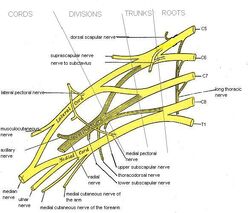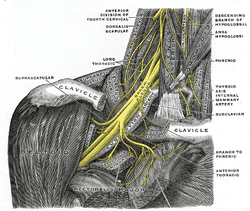Assessment |
Biopsychology |
Comparative |
Cognitive |
Developmental |
Language |
Individual differences |
Personality |
Philosophy |
Social |
Methods |
Statistics |
Clinical |
Educational |
Industrial |
Professional items |
World psychology |
Biological: Behavioural genetics · Evolutionary psychology · Neuroanatomy · Neurochemistry · Neuroendocrinology · Neuroscience · Psychoneuroimmunology · Physiological Psychology · Psychopharmacology (Index, Outline)
| Nerve: Posterior cord | ||
|---|---|---|
| Plan of brachial plexus. (Posterior cord is shaded gray.) | ||
| The right brachial plexus with its short branches, viewed from in front. The Sternomastoid and Trapezius muscles have been completely, the Omohyoid and Subclavius have been partially, removed; a piece has been sawed out of the clavicle; the Pectoralis muscles have been incised and reflected. | ||
| Latin | fasciculus posterior plexus brachialis | |
| Gray's | subject #210 933 | |
| Innervates | none | |
| From | brachial plexus - posterior divisions of the three trunks | |
| To | subscapular, up. and low. thoracodorsal axillary radial | |
| MeSH | [1] | |
The posterior cord is a division of the brachial plexus.
The posterior cord gives rise to the following nerves:[1]
| Name | Roots | Supplies |
| upper subscapular nerve | C7-C8 | subscapularis muscle of the rotator cuff |
| lower subscapular nerve | C5-C6 | teres major also of the rotator cuff |
| thoracodorsal nerve | C6-C8 | latissimus dorsi muscle |
| axillary nerve | C5-C6 | sensation to the shoulder and motor to the deltoid muscle and the teres minor muscle |
| radial nerve | C6-C8 | triceps brachii muscle, the brachioradialis muscle, the extensor muscles of the fingers and wrist (extensor carpi radialis muscle), and the extensor and abductor muscles of the thumb |
References[]
External links[]
- Atlas of anatomy at UMich hand_plexus - "Axilla, dissection, anterior view"
- Illustration at preventdisease.com
| Nerves of upper limbs (primarily): the brachial plexus |
|---|
| supraclavicular: dorsal scapular - suprascapular - to the subclavius - long thoracic
infraclavicular: lateral cord: musculocutaneous (lateral cutaneous of forearm) - lateral pectoral - lateral head of median (anterior interosseous, palmar, common palmar digital, proper palmar digital) medial cord: medial pectoral - medial cutaneous of forearm - medial cutaneous of arm - ulnar (muscular branches, dorsal branch, palmar branch, superficial branch, deep branch) - medial head of median posterior cord: subscapular (upper, lower) - thoracodorsal - axillary (superior lateral cutaneous of arm) - radial (muscular, inferior lateral cutaneous of arm, posterior cutaneous of arm, posterior cutaneous of forearm, superficial branch, deep branch, posterior interosseous) |
| This page uses Creative Commons Licensed content from Wikipedia (view authors). |

